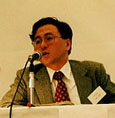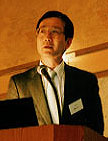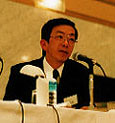GLOCOM Forum: Japan's Revival-Beyond the Clash of Civilizations
Discussion Summary Part 3: The Future of Info-telecommunication Networks: Prospects for Distributed Systems
English summary of the panel discussion in Session 3 at GLOCOM's 10th anniversary forum on November 19, 2001
Panelists:
Masataka OHTA (Professor, Tokyo Institute of Technology)
Kenichi MASE (Professor, Niigata University)
Tatsuro TAKAHASHI (Professor, Kyoto University)
Moderator:
Hajime YAMADA (Professor, GLOCOM)
|
 YAMADA: In this session, we will take up some technological aspects of networks. The first speaker is Mr. Masataka Ohta and he will talk about prospects for distributed systems by focusing on mobile Internet services. YAMADA: In this session, we will take up some technological aspects of networks. The first speaker is Mr. Masataka Ohta and he will talk about prospects for distributed systems by focusing on mobile Internet services.
|
|
 OHTA: I will speak to you as Chief Technology Officer at Mobile Internet Service, Inc. Before talking about mobile Internet services, I would like you to understand what the Internet really is. The Internet is not the same thing as e-mail or even World Wide Web. Instead, the Internet is a kind of info-telecommunication infrastructure and a mutually connected network by using the IP Protocol, based on the Internet principle. OHTA: I will speak to you as Chief Technology Officer at Mobile Internet Service, Inc. Before talking about mobile Internet services, I would like you to understand what the Internet really is. The Internet is not the same thing as e-mail or even World Wide Web. Instead, the Internet is a kind of info-telecommunication infrastructure and a mutually connected network by using the IP Protocol, based on the Internet principle.
The Internet principle is called the end-to-end principle. For one thing, what end terminals can do is not done on the network side. Therefore, the more capable end terminals become, the simpler and thus cheaper and faster the network will be. For another thing, what can be done directly by two connected terminals is not supported by any other terminal. This way we can avoid excessive load on unrelated terminals. Even if a particular server goes down, the network system as a whole will not break down. In this sense, the distributed system is inherent in the Internet.
Since the Internet is a distributed system, it cannot easily be regulated. The dial-up Internet system may be regulated through regulation of network operators who are managing servers in a centralized fashion. In the connected Internet system, however, anyone can operate a server as in the peer-to-peer model and there is no network operator per se to be regulated in a perfectly distributed system. Of course, even in this system we wish to make it possible to track down criminals, so we should be able to identify who is transmitting information.
No doubt the future of the Internet will center around optic fibers. Its speed will be 10Tbps per core and sufficiently fast even ten years from now. But wireless is still useful, because optic fibers need a wire to connect two points, and is useless for one-to-many or mobile communications. Here, security is a crucial problem and is difficult to achieve in the wireless system.
Then, what are wireless Internet services? It is clear that fixed Internet services are the basis and those services are getting faster and cheaper under the flat-rate system. Therefore all we need to do is to attach wireless operating equipment to the fixed Internet. If we have a sufficiently high density of wireless base stations to have each station cover a relatively small area, we will have a relatively high-speed wireless service. But in any case wireless services are much slower than those on optic fibers and, therefore, are better suited for mobile and not for fixed Internet communications.
A problem with wireless is that anyone can transmit and receive messages, so you need authentication to identify whose messages are being transmitted. Therefore, necessary ingredients for wireless Internet services are wireless end terminals, wireless base stations, and authentication servers. Wireless base stations are connected to the Internet via LAN technology, that is, optical ethernet, and wireless end terminals are connected to those base stations via wireless LAN such as IEEE 802.11b with additional security, where authentication servers are connected to the Internet. An important point is that there is no need to connect wireless base stations and authentication servers directly, since they are connected via the Internet.
Given this structure, you can move around a particular base station, but you need "IP mobility" to move across multiple stations in a wider area. The structure of mobile Internet services is such that a security module for authentication and encryption as well as the IP mobility technology for wireless end terminals to move across multiple stations are added to the existing telecommunication system, where communication services are totally distributed except authentication, since wireless routers are directly connected to the Internet.
In this system we can provide a location-dependent service, which is totally distributed, by using a technology called "anycast." That is to give the same IP address to multiple wireless base stations in different locations, so you can gain access to the nearest station, while moving, to obtain location-specific contents or necessary location information by using the same address. This way, mobile Internet services are provided in a perfectly distributed fashion with no privacy control problem, as users receive and use their own location information. Given adequate security we can enjoy mobile Internet communication including these kind of location-dependent services.
|
|
YAMADA: Mr. Ohta has talked about mobile Internet services that are currently in the experimental stage. When we look further into the future, we can think of "voluntary networks" that Professor Kenichi Mase at Niigata University will explain next.
|
|
 MASE: I would like to make a proposal on how to build or manage a new network system, namely, "voluntary networks." The background for this proposal is the fact that there seems to be more and more diversity in the demand for mobile communication, which cannot be met by ordinary mobile technologies or existing networking systems, while wireless technologies are progressing rapidly so that we can build network systems for very small initial and running costs. MASE: I would like to make a proposal on how to build or manage a new network system, namely, "voluntary networks." The background for this proposal is the fact that there seems to be more and more diversity in the demand for mobile communication, which cannot be met by ordinary mobile technologies or existing networking systems, while wireless technologies are progressing rapidly so that we can build network systems for very small initial and running costs.
In the case of existing networks, certain organizations or operators provide their services only to those who are authorized by contract or affiliation. These existing networks, which might be called "authorized networks," will have their limitation in the future, as we will need a new paradigm for system building and management to meet a growing need for free and ubiquitous connections in next-generation computing. We call it "voluntary networks."
In voluntary networks, individuals or organizations voluntarily provide communication resources such as networks and nodes free of charge, and those resources are to be mutually connected via wireless links automatically in a distributed way, where there is no authority to control the whole system and there is free entry for individual communication resources.
For example, we can think of a case where access points (base stations) are placed on house gates, mail boxes, or even car roofs. These access points and mobile end terminals are connected through wireless LAN technologies, and access points themselves are somehow connected even though they might move around. Wireless end terminals can move from one access point to another through roaming services and the whole system may be regarded as a kind of wireless LAN.
Another example is the case of using mobile end terminals, where those terminals are connected to each other automatically in a distributed fashion. This is often called "ad-hoc networks," with end terminals are linked by wireless technologies, possibly including wireless multihop communications with no base stations or fixed networks necessary even in a wide area. In the past, this kind of network has been used among closed circles for military, disaster relief or event purposes. As ad-hoc networks are evolving to be more open with general-purpose applications available, we will be able to use such "next-generation" ad-hoc networks in our voluntary network systems.
Regarding social implications, voluntary networks may be one way of achieving next generation computing with such properties as IP on everything, ubiquitous, nomadic and decoupled computing. Those networks can be utilized for supporting information sharing to revitalize local communities, for developing hotspot services in various regions, for sensing the environment to build a foundation of environmental businesses, and for promoting competition and cooperation with authorized networks to reform the structure of the mobile communication industry.
This is a proposal from the network side to achieve next generation computing. It is a technologically feasible idea, but the basic question is whether the voluntary network idea will be accepted by everyone in the society.
|
|
YAMADA: Both Mr. Ohta's idea and Prof. Mase's proposals presuppose the progress of Internet technologies. In this context Professor Tatsuro Takahashi will talk about prospects for Internet technologies, focusing on IP Protocol.
|
|
 TAKAHASHI: First, regarding networks as a whole, I would like to point out that we are having broader bandwidth for our backbone networks due to new technologies such as WDM and optic routers. Actually, the volume of telecommunication between Internet routers, say, between Japan and the U.S. or between Tokyo and Osaka, has been doubling annually in recent years. This is made possible by applying the WDM technology to optic fibers. If we apply this technology to all the existing optic fiber networks in Japan, we would have approximately 1Pbps, that is, about 10Mbps per capita. At least in terms of infrastructure, therefore, we can develop broadband services without making any more heavy investment. TAKAHASHI: First, regarding networks as a whole, I would like to point out that we are having broader bandwidth for our backbone networks due to new technologies such as WDM and optic routers. Actually, the volume of telecommunication between Internet routers, say, between Japan and the U.S. or between Tokyo and Osaka, has been doubling annually in recent years. This is made possible by applying the WDM technology to optic fibers. If we apply this technology to all the existing optic fiber networks in Japan, we would have approximately 1Pbps, that is, about 10Mbps per capita. At least in terms of infrastructure, therefore, we can develop broadband services without making any more heavy investment.
On the other hand, we currently have electric routers whose capacity is about 100Gbps, and use WDM for long distance telecommunications. We have now developed a new system called "optic MPLS" and will develop optic routers in the near future. Since the demand for Internet communications is increasing rapidly, these new technologies will be needed, developed and utilized sooner than anyone can expect.
Second, regarding protocol, the Internet is no longer a "best effort" communication, but rather like a "black hole" to incorporate various properties suitable for businesses, multimedia applications, etc. In the past we used to compare the Internet with the telephone system in terms of the structure, quality, reliability and other characteristics of the network, but more recently the Internet has become more connection-oriented-- somewhat like the telephone to ensure a certain quality level for business, multimedia, and other large-scale operations. In terms of reliability, the Internet has become an important part of our lifeline, as indicated by the role of i-Mode nowadays. In other words, Internet protocol has now played multiple roles by incorporating the strengths of various network technologies.
Third, regarding access technologies, we now have a number of access methods such as ADSL, optic fibers, W-CDMA, wireless LAN, and ad-hoc networks. Focusing on W-CDMA, a wireless access technology, we have found that it has only 5-10 Mbps/area and cannot provide high-speed streaming services at low costs unless there are some new developments on radio waves for W-CDMA. However, since it is better suited for voice services than wireless LAN and we will have a higher quality i-Mode service in the future, W-CDMA may be combined with end terminals and applications as a set to serve the general public in competition with wireless LAN.
Regarding ad-hoc networks, which Prof. Mase just explained, I think there are two possible roles that they can play. First, it can be used for communications within a community or inside a certain area like in this room. But its major role may be to provide a new access method for the Internet. For example it can supplement the role of W-CDMA and wireless LAN by transmitting radio waves to some isolated areas or providing discount communication services in neighborhoods. Also it can be used to support mobile, ubiquitous computing for everyone in a wide area.
Finally, regarding protocol for ad-hoc networks, there are a number of challenges such as QoS for voice services, which we are currently working on. One difficult question about ad-hoc networks is how to motivate transmission of other people's packets. A possible answer might be the use of virtual money or even real money to facilitate the exchange of transmission services. Since ad-hoc networks are quite suitable and useful in a high-density and congestion-prone country like Japan, I hope we will be able to develop this kind of technology further to make our network services more convenient for our daily life.
|
|
YAMADA: Now that we have heard the panelists' presentations, I would like to ask them a few questions. My first question is how to offer a certain level of service to everyone in Japan. Mr. Ohta and Prof. Mase, please.
|
| OHTA: In the case of wireless Internet services, we can offer our service nationwide if we set up a number of base stations comparable to PHS stations, namely 160,000 to 200,000 stations and charge 2,000 to 3000 yen per month.
|
| MASE: Voluntary network services could be provided nationwide if automobile companies decide to place access points (base stations) on all the cars they sell, or if all the local governments decide to distribute access points in their respective communities. But voluntary networks are "voluntary" in nature and may not become nationwide.
|
| YAMADA: The second question is how to deal with vulnerability in terms of security and contingency for our distributed system as a whole.
|
| OHTA: We might offer battery-operated base stations or have two stations cover a partially overlapping area to secure reliability in case of power failure, etc. In case of crimes, we would certainly cooperate with the authorities to track down criminals.
|
| TAKAHASHI: Regarding network services, there are many ways to deal with their vulnerability. But the most serious problem is intentional attacks by hackers and other malicious users. It is quite costly and inconvenient to have sufficient security measures against such attacks, and it will get worse when we have a distributed system, where it is more difficult to detect and grasp such problems than with a fixed system.
|
| YAMADA: My next question is how to deal with "important public transmission," as pointed out by Professor Hayashi in the previous session.
|
| OHTA: I do not see any serious problem in dealing with such transmission in our best-effort system, although it may be slow in transmission. In addition, if we wish we can use a device installed in IEEE802.11b to make way for important public transmission.
|
| MASE: It is rather difficult to think of voluntary networks to deal with important public transmission, and that may be a more suitable task for authorized networks. But, on the other hand, we can utilize a voluntary network to call for immediate help in case of emergencies, so voluntary networks themselves will enhance security in general.
|
| YAMADA: My final question is how to think of FTTH (fiber to the home) in contrast to mobile Internet services and voluntary networks.
|
| OHTA: I think FTTH should be promoted for the sake of fixed or semi-fixed (hotspot) Internet systems. On the other hand, mobile Internet services will be provided at the speed of 11Mbps for mobile end terminals to send pictures, etc. Basically we welcome the development of the optic fiber system, since we wish to attach more wireless operating machines to those fibers.
|
| MASE: I also welcome FTTH from the viewpoint of voluntary networks, given that idle bandwidth is offered for voluntary network users. It would be nice if we as outsiders can use wireless LAN at any company or organization that we visit. That way, the concept of voluntary networks might be extended to cover both wireless and wired networks.
|
| TAKAHASHI: First, from the technological point of view, optic fibers are much better than anything else and therefore will dominate in the future. But the question is timing. Due to various technological possibilities such as wireless technologies, the lifespan of metals is getting much longer than we expected. The second question is who will build optic fibers and how. In the U.S., for example, the government spent a substantial amount of public money to support the development of Internet technologies, but once it was successfully developed for business purposes, the government stopped its support and left it to the private sector altogether. On the other hand, in Japan it is often argued that the central or local governments themselves should build an optic fiber system, in sharp contrast to the U.S. approach. I tend to think that it should be left to the market mechanism.
|
| YAMADA: Let me mention that in the wake of the terrorist attacks in New York, it was reported by many people that the telephone system did not work, but the Internet did. This happened because the Internet system is basically separate from the telephone system. Given this episode, we might as well have wireless distributed systems, some metals, CATV, etc. in addition to FTTH simultaneously to increase the reliability of our communication system as a whole.
|
|





